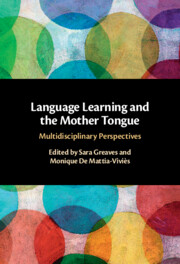Book contents
- Language Learning and the Mother Tongue
- Language Learning and the Mother Tongue
- Copyright page
- Epigraph
- Contents
- List of Contributors and Their Works
- Acknowledgements
- Introduction
- Part I The Mother Tongue and Second Language Learning
- Part II From the Mother Tongue to the Second Mother Tongue
- Part III The Second Mother Tongue as a (M)other Tongue and the Return to the Body
- Subject Index
- Author Index
Introduction
Published online by Cambridge University Press: 16 June 2022
- Language Learning and the Mother Tongue
- Language Learning and the Mother Tongue
- Copyright page
- Epigraph
- Contents
- List of Contributors and Their Works
- Acknowledgements
- Introduction
- Part I The Mother Tongue and Second Language Learning
- Part II From the Mother Tongue to the Second Mother Tongue
- Part III The Second Mother Tongue as a (M)other Tongue and the Return to the Body
- Subject Index
- Author Index
Summary
The introduction sets out the dual purpose of the book: to present the editors’ research on the residual presence of the Mother tongue in second language learning, and to showcase a selection of essays by Francophone authors whose thinking on the Mother tongue has influenced their own. They wish to introduce the concept of the langue mat-rangère, or ‘(M)other tongue’. This term conveys the way the second language comprises an in-matrie dimension that underlies speech in a foreign language. By presenting the foreign language as an act involving the body, they highlight the place that should be given to the mother tongue in second language learning. Thanks to the multidisciplinary creative pedagogy they promote, the forgotten or repressed mother tongue finds its place again, making it easier to learn the foreign language. Two second language learning situations are described: the foreign language started at school, usually at about eleven years old, and the second language that is grafted onto the original language in a context such as migration. Both situations reveal a common denominator between them: the central role played in second language learning by the original Mother tongue, in its most archaically emotional, sensory, and bodily dimension.
Keywords
- Type
- Chapter
- Information
- Language Learning and the Mother TongueMultidisciplinary Perspectives, pp. 1 - 12Publisher: Cambridge University PressPrint publication year: 2022

